Content marketing processes can be very hectic.
There’s a lot of back and forth communication between different departments and teams. Unless you organize all that into a strict procedure, you’re going to be hearing a lot of…
- “Why isn’t the article published? It was due today!”
- “Where are the graphics for the new article?”
- “Wait, so what’s up with that article that’s been in draft for 2 weeks?”
And we’re not making all that up from thin air, either. At Tallyfy, we publish a lot of content. And when there’s a lot of output, there’s a lot of chaos.
It doesn’t necessarily have to be all chaotic, though.
To keep us all sane, we automated the content marketing workflow with our own workflow management software. We defined the entire process through a flowchart and used the software to keep track of the workflow.
How to Use Tallyfy to Automate Your Content Marketing Workflow
Content marketing isn’t the most popular use-case for workflow software. It can have the potential, though, to make the process significantly more efficient.
If you’re not sure how the software works, here’s a brief overview.
The gist of it is that workflow management software allows you to digitize your business processes.
For content marketing, you probably have a very standard routine – you write the article, edit it, create the graphics, optimize it for Google, etc.
Here’s what our content marketing workflow looks like…
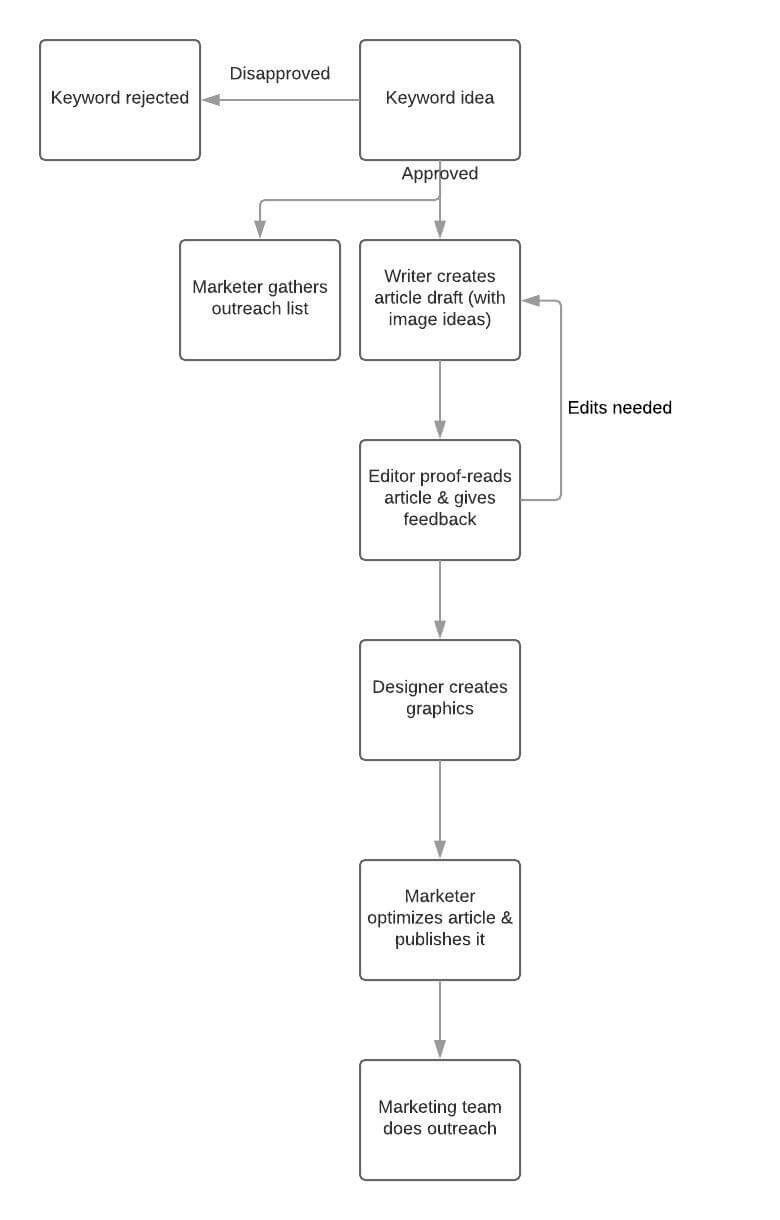
And roles of the employees carrying out the process are as follows…
- Writer – The person in charge of actually writing certain content
- Editor – Ensures that the writer’s work is on par with the Writer Guidelines
- Designer – Creates relevant graphics for the article (or an infographic in certain cases)
- Marketer – Analyses the article title, uploads on WordPress and optimizes it for Google, reaches out to relevant influencers, channels, etc.
So where does the workflow software come in, you might be thinking. The process seems to be pretty straightforward.
Well, here’s the thing. The processes are straightforward but they’re hard to enforce. You can’t just stand on your designers back (or writers, or editors, etc.), making sure that they’re sticking with the procedure.
Sometimes, deadlines can slip by. The editor might have forgotten about the article, the designer could have gotten caught up with other work.
Whatever the case might be, workflow management software can prevent this automating the enforcement of the process.
The relevant employees get a dashboard consisting of the tasks they’re working on.
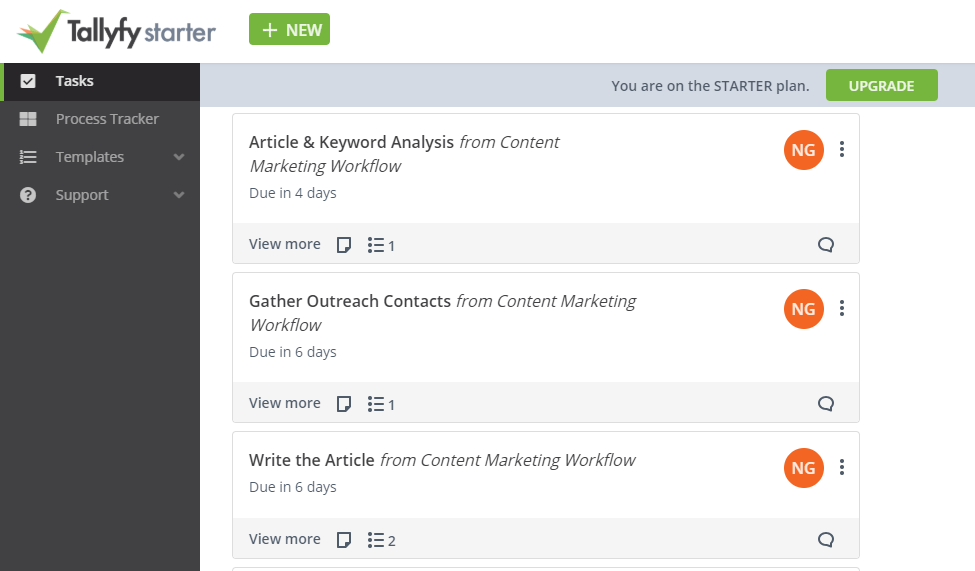
This keeps track of the process stage, progress, etc. Once someone finishes their process step, the next relevant team member automatically gets the next task assigned to them.
The software will notify the manager if there are any missed deadlines or bottlenecks, ensuring that the process goes smooth.
If that sounds like something your business could benefit from, read on! We’ll explain how, exactly, you can use Tallyfy to automate your content marketing workflow.
Step #1: Article / SEO Analysis
Before you can even start work on an article, you need to make sure that the topic is relevant to your business.
In our case, we mostly publish content that has a chance of ranking on certain keywords. So, the analysis part is mainly in terms of whether the keyword is relevant for us. Meaning, if it has enough searches per month and it’s relevant to process management, etc.
Any writer can start a process for whatever keyword & the analysis task will be assigned to the marketing lead.
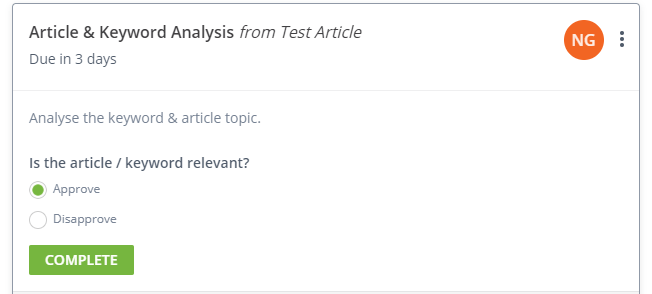
The marketing lead analyses the keyword and sees whether it’s worth chasing or not, and approves or disapproves the keyword. The marketing lead can also include information about the keyword – the article has to be 2,000 words long, include X and Y topics, etc.
If the article is approved, the workflow moves to the next step. If not, the process is canceled and keyword abandoned.
Step #2: Gathering Outreach Channels
While SEO can be very beneficial long-term, it can take months or even years to kick in.
We don’t want the article to just sit there on the blog post, hoping that one day, it gets discovered.
To really get the most out of the piece, we find all sorts of channels that would find the article useful. This can be anything – Facebook groups, forums, blogs with a large following, etc.
So, once step #1 is complete and the article is approved, the marketing team gathers a list of all the channels we need to reach out to & puts it all on Google Sheets.
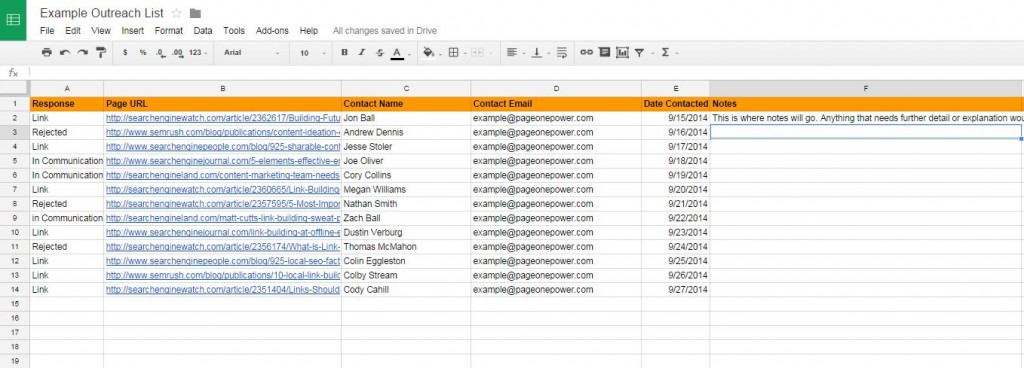
If you want to learn more about creating an outreach list, check out the guide by PageOnePower
They submit the link to the sheet within the workflow, which will eventually reach the marketer that’s in charge of actual outreach.
Step #3: Writing the Article
This one’s pretty straightforward. The assigned writer gets a notification that they’re supposed to start work on a given article.
If the marketer included information that’s necessary to be mention in the piece, the workflow delivers it to the writer.
Once the article is done, the writer inputs the link within the software, mentions any relevant graphics that the piece would need (for the designer), and completes the step. The system notifies the editor that it’s time to review a new article.
Step #4: Editing the Article
The editor receives the article link, goes the piece & makes comments according to the writer guidelines.
If the article only needs some minor edits, the editor fixes it up on their own & completes the step. If there are any major improvements to be done, the task goes in a feedback loop between the writer & editor until it’s polished.
Step #5: Creating Graphics
Once we have a final draft ready, the task is assigned to the designer.
According to the writer’s instructions, they create relevant images, input the link to the software, and finish the task.
Step #6: Publish and Optimize for Google
The marketer uploads the article on WordPress, uploads any images and optimizes it for Google…
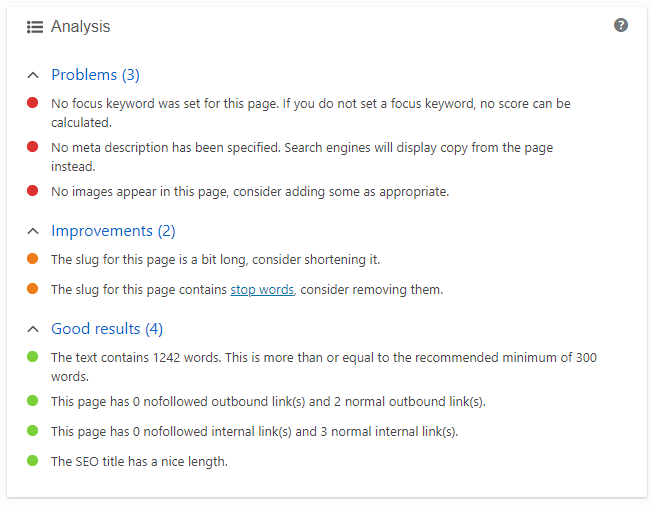
If you’re not too fond of Yoast (or are using a custom CRM that’s not based on WordPress), you can also create a workflow for search engine optimization.
What you’d be doing here is creating a spin-off process specifically for the marketer. It would include all the must-have best practices for SEO & be under the marketer’s ownership. So, thinks like…
- Make sure the article has 0,5% to 1% keyword ratio
- Include 3-4 internal links
- Include 3-4 external links
- Include alt-text for all images
- etc.
Step #7: Marketing Outreach
With the article published, it’s time to use the outreach list we created in step #2.
The marketer goes through the list and starts the distribution process. Meaning, sending out all the emails, posting in Facebook groups, etc.
Once they’re done with the outreach, the content marketing workflow is marked as “complete” and you call it a day (until, of course, you restart the process for the next article).
Getting Started With Your Own Content Marketing Workflow
If your content marketing process looks just like ours, you’re in luck!
Simply register on the platform and use our template. If your strategy is a bit different, though, you can always make some adjustments to it.
Whichever the case may be, Tallyfy is free to start for up to 5 users – which is more than enough for a small content marketing team. Those usually consist of…
- 2x Writers
- 1x Editor
- 1x Designer
- 1x Marketer
So, register now & see how workflow management software can improve your content marketing efficiency!

